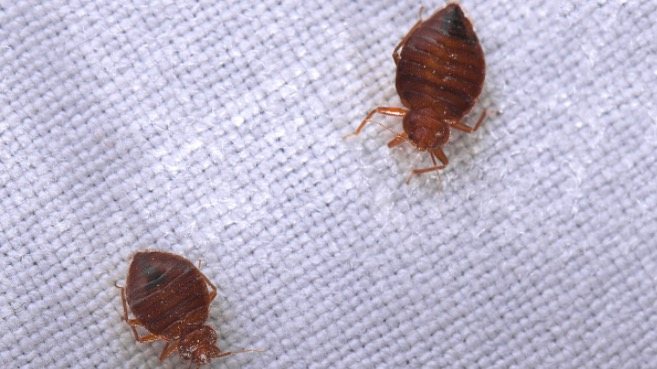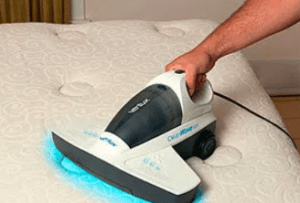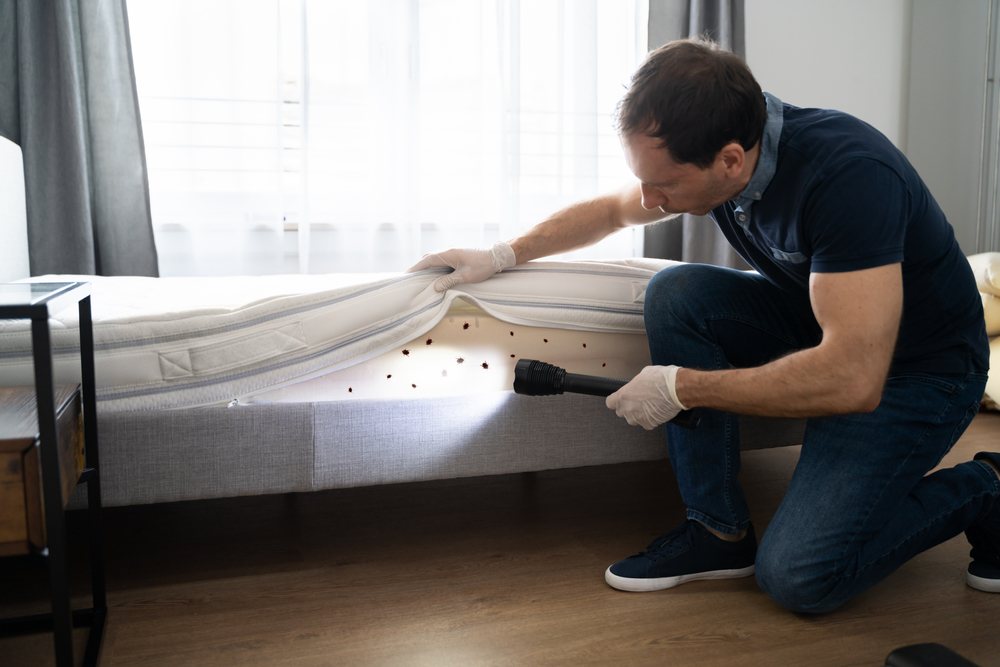Have you come across a bed bug infestation? There’s no reason to be embarrassed, bed bug problems are more common than people think. The cleanliness or quality of the apartment has little effect on its vulnerability to infestations from these pests.
After you’re left with irritated skin and tainted furniture you’re often left wondering where these bed bugs came from. Even though these critters cannot fly, they’re expert travelers through the ability to hitchhike in any of the following places:
- Clothes
- Luggage or handbags
- Furniture purchased from used furniture stores
- Certain places on your body
What Do Bed Bugs Look Like?
If you suspect that a bed bug infestation is present in your apartment, the first step is to properly identify the bugs you’re seeing.
Bed bugs have the following traits:
In general, an adult bed bug is reddish-brown with a round body. About the size of an apple seed, bed bugs will either be flat or look like tiny red balloons. This completely depends on whether they have fed on blood recently.

When left untreated bed bugs can spread through mattresses, bedding, or your luggage, and can even hitch a ride through your friends or loved ones. It’s important to identify bed bugs over similar insects so that you can take necessary action.
Report Your Bed Bug Problem
Now that you have properly identified an infestation, you should contact your landlord or building management immediately. You should receive a response within a week about next steps.
Some states have specific laws about how quickly a tenant must report the infestation after it is discovered.
For example:
Philadelphia: A new ordinance in late 2019 requires tenants to report an infestation within 180 days of discovery, at which point the landlord is responsible for investigation and remediation costs.
Phoenix: There are laws that apply where tenants shouldn’t knowingly bring anything into their apartment/house that contains bed bugs. It also requires tenants to report the infestation to their landlords but no specific time frame is given.

Preparing for the Inspection
Strong lines of communication are important between the tenant and landlord in order to properly coordinate the bed bug inspection.
At this point a pest control professional should have been hired and a date should be scheduled for the inspection to take place.
The following places in the apartment will likely be examined thoroughly:
- Mattress, Box Spring, and Bedding – To help prevent future infestations once the inspection/treatment is completed. You should consider purchasing special bed bug mattress covers.
- Behind Furniture – Pest control will likely need to move major pieces of furniture to locate bed bugs hiding behind or inside.
- In Drawers, Closets, Shelves – Bed bugs like to hide in dark places so they’ll need to look through your belongings which may seem more intrusive.
Pest control will also look to determine where the infestation began and learn how it spread. Often times infestations start with only one bed bug, and mapping an infestation can determine where it started, and who is to take financial responsibility.

Certain states such as Arkansas, have little to no protections for tenants. Therefore the cost of extermination will almost always fall on them. In other states tenants are given responsibility if they willfully and recklessly caused the infestation and failed to report it.
Pest Control & Pre-Treatments
Before the actual chemicals are dispersed, pest control will work with the tenant to prepare the apartment for treatment.
Dismantling Bed Frames
They’ll begin by dismantling bed frames and standing up the mattress and box spring. They will shine a special flashlight through the fabric to look for bed bugs.
Thorough Cleaning
Next pest control will scrub infested surfaces with a stiff brush to dislodge eggs. They will then vacuum the room extensively, getting at cracks/crevices and along the walls. A successful cleaning job will remove particles and dust to ensure greater insecticide penetration.

Caulk and Seal
The last step to the pre-inspection process is sealing all holes where pipes and wires penetrate walls. Filling cracks around baseboards and molding to reduce areas where bed bugs can hide.
The Bed Bug Treatment
There are a number of options to effectively get rid of bed bugs, so it can be difficult to decide which method is best for your situation. Here is some basic information regarding the two most common methods to kill bed bugs.
Bed Bug Heat Treatments
One of the best methods for treating bed bugs is the whole room heat treatment. This involves specially designed equipment that heats the apartment to extreme temperatures. Bed bugs in all life cycles (eggs, nymphs, adults) cannot survive longer than 90 minutes above 118 degrees Fahrenheit (48 degrees C).

This treatment works by drying out the bug’s bodies, but the trick is getting every square inch of your home to that temperature. Professionals use sensors to monitor temperatures in the hard to reach places where bed bugs could be hiding.
The heat doesn’t damage most household items but certain things should be removed like meltable plastics, oil paintings, and pets.
The benefits of Heat Treatment
- This option is 100% ecofriendly
- It kills bed bugs in all life stages (if implemented properly)
- Typically, only requires one treatment visit
- Bed bugs are becoming increasingly resistant to chemical products that are involved with conventional treatment.
2) Chemical Bed Bug Treatment
This treatment involves different insecticides which are administered in every area of the home. The professionals will spread insecticide in furniture, beds, mattresses, closets, kitchen areas etc..
The entire home is essentially blanketed in chemicals. During this process, all residents and pets need to be evacuated for at least half a day to ensure safety.

The Benefits of Conventional Treatment
- This option is typically less expensive compared to heat treatments.
- This is more of a direct method of treatment so it could make more sense for smaller, less severe infestations.
- This method is more discreet, compared to heat treatment which requires vans and big industrial equipment.
Who Pays for the Bed Bug Treatment?
It can be difficult to determine who is responsible for an apartment that becomes infested. In some cases, bed bugs can come from a tenant’s clothes or baggage, in other cases, it can come from a multi-unit dwelling.
The laws governing financial responsibility varies from state to state, but more and more states are putting the burden squarely on landlords. The NPMA (National Pest Management Association) compiled state specifics laws and regulation in one document.
Property owners and management are typically in a better position to treat this, especially in multi-unit complexes, treating one unit may not be enough.

Most states point to the implied warranty of habitability, requiring landlords to provide habitable housing, luckily for tenants, most courts don’t consider bed bug infested units to be habitable.
The situation where you as a tenant are likely held responsible is if you live in a single-family home – Especially if you have lived there for more than 2 years.
Note: Renters insurance typically won’t pay for the removal of bed bugs or any damage that an infestation caused. Therefore it’s likely you’ll be paying for the cost of extermination from your own pocket.
If you can’t avoid professional bed bug treatments (which can cost thousands of dollars) you can check out these Do-It-Yourself treatment options.
What To Do If Your Landlord isn’t Cooperating
Depending on the law in your state, if your landlord isn’t responding in a timely manner or is failing to take care of a bed bug infestation you might have some options.

- Write a bed bug demand letter – State your case and demand that the landlord deals with the problem. Potentially stating a lawsuit as consequence for inaction.
- Withhold rent
- Reduce the cost of a bed bug treatment from your rent
- Move out early without being held to your lease
- Sue your landlord – A lawyer will determine whether you have a case for a lawsuit. Get your free consultation now – with no fees unless you win your case.
Before you take any of the above steps you should consider local laws and ordinances. Some areas don’t allow tenants to withhold rent without penalty, so as a tenant you should do your research before taking any serious action.
Click here more information from NOLO’s legal encyclopedia on your options as a tenant against your landlord if they fail to handle habitability problems at your residence.
Top Bed Bug States & Statistics
Every year Orkin comes out with a list of the top 50 most bed bug infested cities in America. This list is based on treatment data where Orkin performs the most bed bug treatments.
If you’re looking to see where your state stacks up, view Orkin’s list of top bed bug cities in 2020 here.

Important Bed Bug Statistics below:
84% of pest professionals suggest that bite victims aren’t able to properly identify bed bugs.
59% of bed bugs found are actually in nursing homes.
97% of pest professionals performed at least one bed bug treatment in 2018.
From Google Trends, we can see interest over time for “bed bug” related searches.
Click here for more impactful statistics related to bed bugs.
Get Connected with a Bed Bug Lawyer
If you or a family member came in contact with a bed bug infestation, you may be entitled to compensation. We can connect you with a licensed bed bug attorney in your area for a FREE CONSULTATION, to discuss next steps and how to build your case. If we feel you have grounds for a case, our lawyers will work with you for no fees unless you win.




